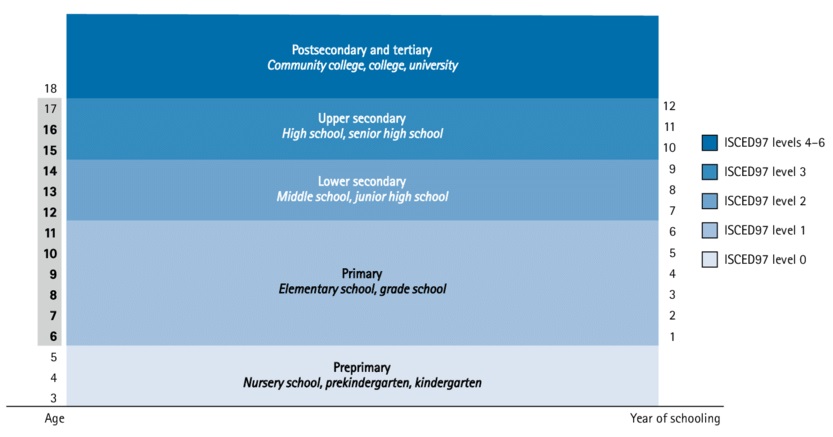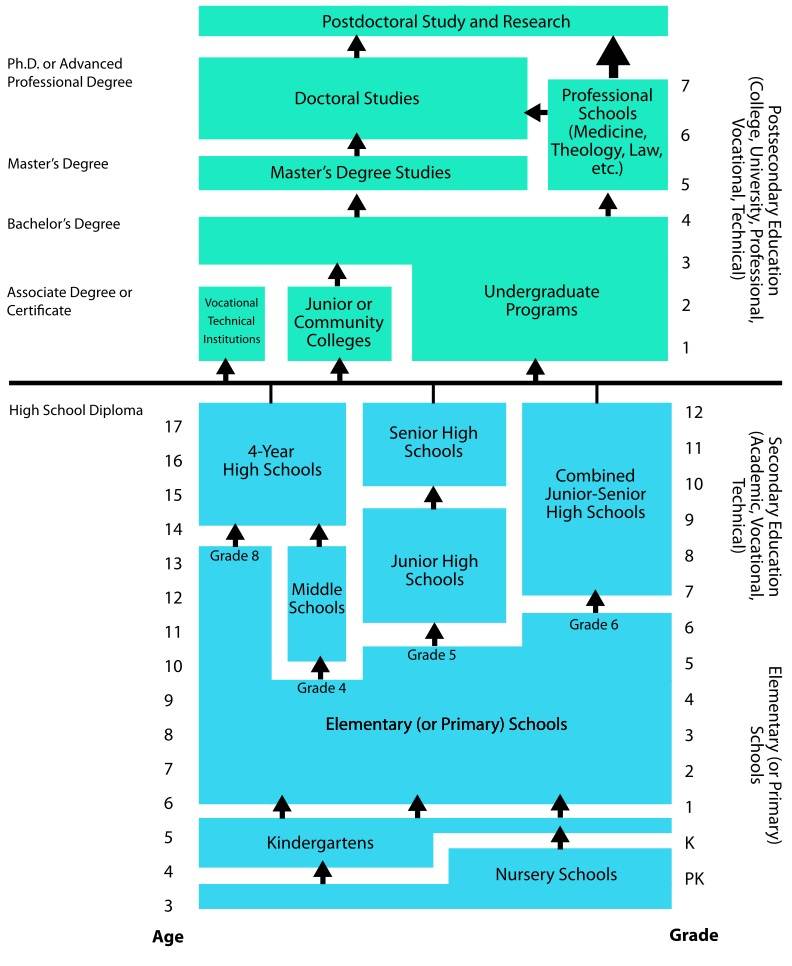The United States boasts a diverse and expansive education system, encompassing five distinct levels: Kindergarten, Elementary School, Middle School, High School, and College/University. Each stage serves as a building block, shaping students' knowledge, skills, and aspirations. A standard K-12 curriculum forms the backbone of education, covering subjects like mathematics, science, language arts, history, and social studies.

Image: Research Gate
No National Curriculum in the US
Interestingly, the United States' unique educational landscape stands in stark contrast to nations like the UK, Australia, Canada, and India, which typically have centralized educational systems with national curricula. This decentralized approach in the US, enshrined in the Elementary and Secondary Education Act of 1965, has shaped the nation's educational philosophy for decades. While the federal government provides funding for primary and secondary education, it does not dictate curriculum content. Instead, states and local school districts have significant autonomy in designing their educational programs.
This explainer covers the path of U.S. education, from preschool through higher education, highlighting the key stages of development, teaching methodologies, and the structure of each phase.
US Educational Stages Explained

Preschool (Ages 3-5)
Preschool, also known as pre-kindergarten, is the starting point for many children in the U.S. educational system. It is a non-compulsory, classroom-based form of early childhood education provided for children aged three to five. While not mandated by law, many parents choose to enrol their children in preschool as a way to prepare them for the more structured learning environment of elementary school.
Preschool education can be delivered through standalone preschools, early childhood centres, or attached to an elementary school. The primary focus is on developing basic cognitive, social, and motor skills through play-based learning. Children are introduced to letters, numbers, shapes, and colours, and they begin to develop early literacy and numeracy skills. Preschool also places significant emphasis on socialization, as children learn to interact with peers and follow instructions from teachers.
Some preschool programs are public and funded through state or federal initiatives like Head Start, which serves low-income families. Others may be private, with specific educational approaches such as Montessori or Waldorf methods.
Elementary School (Ages 5-11)
Elementary school marks the beginning of compulsory education in the United States. It typically starts at kindergarten (age five or six) and continues through to grade 5 or 6, depending on the school district. The primary focus of elementary education is to provide a foundation in reading, writing, mathematics, science, and social studies, while also developing critical thinking, creativity, and social skills.
In most elementary schools, the curriculum focuses on basic subjects, and students remain in the same classroom for most of the day, except for specialized classes such as physical education (PE), music, and art. The introduction of technology, critical thinking, and problem-solving begins at this level, preparing students for more complex studies in future years.
In some variations, elementary education ends at grade 5, with students moving on to middle school for their sixth grade. In other regions, students may transition directly to junior high school for grades 6-8.
Middle/Junior High School (Ages 11-14)
Middle school, also known as junior high, is a transitional phase that generally includes grades 6 through 8. This stage marks the shift from the more structured, single-teacher environment of elementary school to a more dynamic system where students switch classrooms and teachers according to subjects.
Middle school serves as a bridge between elementary and high school, preparing students for more advanced learning and greater independence. Students begin taking more specialized classes in subjects like English language arts, and mathematics (including maths, science, and social studies. Elective subjects such as foreign languages, technology, and art are introduced, allowing students to explore areas of interest outside the core curriculum.
This stage also focuses on emotional and social development, as students navigate the challenges of adolescence. Schools often provide guidance counselling and extracurricular activities to support students' personal growth.
High School (Ages 14-18)
High school encompasses grades 9 through 12, generally covering the ages of 14 to 18. It is the final stage of compulsory education in the U.S. and serves as the foundation for either entering the workforce or pursuing higher education.
Key Grade Levels in High School:
9th Grade: Freshman
10th Grade: Sophomore
11th Grade: Junior
12th Grade: Senior
At the high school level, students are given more independence and responsibility for their academic progress. While they are required to take a set of core courses (such as English, mathematics, science, and social studies), they also have the opportunity to select electives in areas of personal interest, such as art, music, technology, or vocational studies.
High school is a critical period for preparing students for the future. In addition to academics, high schools offer a range of extracurricular activities, including sports, clubs, and student government, all of which play an important role in shaping students' skills and interests. Guidance counsellors help students navigate their post-secondary options, whether it be applying to college or exploring vocational training.
Higher Education (Ages 18+)
Higher education in the U.S. is optional but serves as the final stage of formal learning for those pursuing academic or professional advancement after secondary school. The U.S. boasts more than 4,500 accredited higher education institutions, including community colleges, four-year colleges, universities, and technical or vocational schools.
Higher education is divided into several categories:
Associate Degrees (2 years): Typically offered by community colleges, associate degrees are two-year programs that provide basic education in fields such as nursing, business, or technology. Students can either enter the workforce directly or transfer to a four-year university to complete a bachelor's degree.
Bachelor's Degrees (4 years): Most commonly associated with four-year colleges and universities, bachelor's degrees are comprehensive programs of study in fields like engineering, arts, sciences, and business. Students take general education courses in the first two years and focus on their chosen major during the last two years.
Master's Degrees (1-2 years): After earning a bachelor's degree, some students pursue master's degrees in specialized fields such as law, medicine, education, or business. These programs typically last one to two years and are focused on advanced study in a particular discipline.
Doctoral Degrees (3-7 years): The highest level of academic achievement, doctoral programs, such as Ph.D.s, involve extensive research, study, and the completion of a dissertation. Programs vary in length depending on the field of study.
Accreditation and Institutional Differences
One notable aspect of U.S. higher education is that institutions are not centrally managed or organized. Instead, they are accredited by independent bodies that operate on a national or regional level. This decentralised system allows for a great deal of variety in terms of academic offerings, reputation, and competitiveness among institutions.
For instance, prestigious institutions like Ivy League universities have highly competitive admissions processes, while community colleges often have open admissions policies, allowing a broader range of students to enrol.
Conclusion
The US educational system is designed to be flexible and adaptive, providing students with a broad range of academic and vocational opportunities from preschool through higher education. Each stage plays a vital role in preparing students for the next level, whether it's the transition from preschool to kindergarten or from high school to college. With its combination of compulsory and optional stages, the U.S. education path supports the diverse needs, interests, and future goals of students across the country.
Also read: What is US Fed Rate Cut? Why It Happens, and How It Affects the Common Man and Markets
Comments
All Comments (0)
Join the conversation